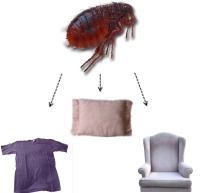Fleas have been around for a long time, joyfully sucking the fresh
blood and being a general nuisance for the hosts of ancient times. Here,
in modern times, has anything really changed? Nope, fleas are still just
as annoying back then as they are now.
Let's face it, fleas are irritating, can cause medical problems, and
arn't very courteous when they decide to suck the blood out of you and
your pet. If we want to combat these pests, we need to take an
in-depth look at a flea's life style. Only after fully understanding these
high jumping insects, can we truly identify the ways to conquer them.
What is a Flea?
Since I am a breeder, my Chihuahuas and I have battled against fleas a few times. Fleas are wingless parasitic insects, dark in color, with tube-like mouth-parts designed to pierce through skin and suck the blood of their host. Their agility is unmatched because of their extraorindarily long legs, and their bodies are covered in hair and spines that point backward, permiting them to manuever around us with little difficulty. The flea's hardened bodies allow them to withstand immense amounts of pressure, rendering our attempts to scratch or smash them fairly ineffective. Basically, fleas look terrifying and are difficult to kill, and you know what else they are great at? Jumping!
Jumping with the long legs fleas' have give them the capability of reaching heights up to 7 inches vertically, and up to 13 inches horizontally. Different sources say fleas can jump around 100 to 200 times their own body length. That's like a human jumping over two football fields with a single leap, which would be fun until we broke our legs with the first leap. Oh well, while the fleas are having all the fun with their superpowered jumping abilities, we'll be the ones smiling after we've exterminated them.
Before the exterminating part, first let's figure out where our springy nuisances live; this will aid us in removing them later.
Where do Fleas Live?
Fleas thrive in temperature climates of 70° to 90°F, making the majority
of modern houses ideal breeding grounds for them. Female fleas lay up to
50 eggs per day, totaling around 600 in a lifetime, and that is only from
a single female!
Imagine there being 10 female fleas laying eggs; that'd be 500 eggs in a
single day! Now factor in that it only takes on average, one week, for baby
fleas to hatch and you can see how quickly they are able to multiply.
Pick your jaw up off the floor, take deep breaths, and relax. Things may
be looking bleak, but we have to keep learning! We'll get through this.
You know what's even more frightening? We inadvertently help the female
flea distribute her eggs throughout our home by simply walking around!
How is that even possible? Well, a female flea will lay eggs in batches of 20, directly on top of us. Yeah that's right, whether the eggs are firmly planted on us are of no concern to her. She'll recklessly drop them anywhere, fully apathetic as to where her kids end up. Because of this, when we sit down on our couches and chairs, or lie down on our beds, the eggs roll off and contaminate everything. This is typically why the host's resting areas are inhabited by large quantities of flea eggs and adult fleas. Such a dirty tactic for them to use against us!
Lifecycle of a Flea
While we are accidently filling our houses with flea eggs, let's figure out the intricate lifecycle of a flea. It goes something like this: A female lays her egg, in about one weeks time, the egg hatches and out comes a worm-like larvae. Unsuprisingly terrifying, the larvae has no eyes, but only a mouth to feed itself. The larvae grows up into a pupae, and eventually settles into a cocoon, kinda like a butterfly. The pupae then shrewedly waits inside the cocoon until a host with fresh blood walks nearby, that'd be us. Seizing the opportunity, the pupae hastily unzips its cocoon and leaps with all its might towards their new home, where they begin feeding on our blood and become what we know them as... fleas.
Alright, now we're getting somewhere. So far we've established what fleas are, where they live, and their lifecycles. We would benefit from learning one final piece of information: the medical dangers fleas pose to us.
Medical Problems
Normally you won't feel a flea bite until after they finish sucking your blood. The resulting irratation of the skin, caused by the flea's saliva, is what you'll feel and try to itch. As the standard for any bite, the visual aftermath is usually a swollen, tiny red dot with a little hole in the middle where the flea bit you.
Reactions to a flea bite vary heavily depending on the individual. Some may not react at all, even if they are bitten for months at a time. Others whose bodies are more senstive, may have severe reactions with inflammation or a rash within the bite's vicinity.
In intense cases, its possible for someone to get anemia, tapeworms, or stomach flus from a bite. If this weren't scary enough, fleas can also act as transporters for diseases. Capable of transferring an assortment of bacterial, viral, and other dangerous diseases from animal to animal, and animal to human.
Great! I say that with extreme sarcasm in my voice, by the way, because we realize now that not only are fleas terribly annoying, but they can potentially make us or our pet very ill. Surely, the time has finally arrived for us to vanquish these blood sucking insects from the depths of our home, for everyones safety!
Treating Fleas in Humans, Animals, and Homes
Stop. Biting. Me... ARRGH! While the details of a flea's life are somewhat interesting, let's brush that aside and concentrate on the killing part. Sometimes you can feel fleas crawling on your skin, or if you focus hard enough, see them scurrying around in your pet's fur. To effectively remove the infestation of fleas in your home, the work involves more than just washing the both of you clean; it entails cleansing the entire enviroment inside your household.
You: Removing fleas from yourself is easy. Take the clothes you currently have on, throw them in the washer, and then hop into the shower. The flood of water will flush them off your body, so start focusing on your hair, because this is where the majority of the fleas are residing. Give them a heaping serving of shampoo to eat. It's not blood, so they'll probably hate it. If you still itch, there are numerous itching creams you can apply to lessen the pain of those areas.
Animals: For dogs and cats, the most popular, effective, safe, and veternarian recommended medical treatment for fleas are Frontline and Advantage. It's easy to apply, too. Just put the advised amount on the nap of their neck, their bodies absorb it through the skin, and within 12 hours those fleas will drop off dead.
Come summer time, in the warm temperatures of CA, fleas start to breed here in California but my Chihuahuas are protected using similar flea medications, with satisfying results. Give it a try!
After applying the medication, consider sending your pet to the frontlines to absorb as many fleas as possible. Your pet will act as a death magnet for any flea foolish enough to hop aboard.
Home: It's time to start cleaning, and I'm talking some heavy duty cleaning. You need to wash everything. That includes pillows, bed sheets, drapes, etc; all with hot water. If you have carpet or rugs, then use the best weapon in your arsenal: the vacuum cleaner. Fleas love to suck blood, and now you can give them a taste of their own medicine by sucking back... or something like that. Anyways, vacuum thoroughly and often. In your house, the vast majority of fleas, eggs, or whatever strange form they may currently be in, can be killed with frequent vacuuming.
Contemplate on bringing a dehumidifier to the battle. A flea's survival is heavily reliant on the humidity in the air. Take that aspect away and their lifecycle takes a massive hit, resulting in less fleas. With the right mixture of mass cleaning, vacuuming, and a dehumidfier, those pesky fleas will be fleeing for the hills. Sorry, I couldn't help myself. Actually I could have.

Just a few household objects that can become infested with fleas.
Fleas can live on you, your
pet and your furniture!

I'm from good old California, and a Chihuahua lover that sells some the the most beautiful Chihuahua puppies you'll ever see, and that is no exaggeration! My Chihuahua puppies live a flea free life, but that can change after they leave my care. If you read the above article, then you probably already have some kind of idea on how to combat the flea menace, but how about learning other useful things like feeding or the dangers of chocolate?
Below are a few puppy related articles and guides to help educate new puppy owners to better care for their pets. Enjoy!
Caring For Small Puppies - How To Guide
Thinking about getting a new puppy? Then you will need to know how to properly care for them. It's not that hard, really, but there are certain things new puppy owners can do to help make their puppy's life more comfortable and a lot safer. Learn more about a puppy's safety with this how to care for small dogs guide. Lots of puppy care info there for you!
For instance, did you know the electrical cords you have laying on the ground can be chewed through by a puppy, resulting in a fatal shock? You did? Well, for the less keen people, there are multiple dangers present in a home, some of which are easily overlooked with unfortunate consequences. So hey, why not take a minute and learn about those dangers and how to prevent them? Your puppy will live longer, and as a result, he'll be way happier!
Feeding Small Puppies - How To Guide
Pop quiz: what do you feed a new teacup Chihuahua puppy? Dry food is a good answer, but how about Esbilac Puppy Milk, Nutrical, or Goats Milk? Maybe these 3 things are not something you need to give a puppy every day, but what they can do is help support your Maltipoo as they grow. There are more food related items that can offer support to your new puppy, and reading this how to feed small dogs guide will teach you just what they are.




Source: Wikipedia
Hypoglycemia in Small Dogs - Low Blood Sugar In Puppies
Hypoglycemia in puppies is no laughing matter, it's a serious threat to their health. There are multiple causes of hypoglycemia in dogs, which include things like stress, getting too cold, or an underlying illness. My puppies rarely ever get low blood sugar, because they are strong and healthy. However, the opportunity may arise where a stressed out puppy will stop eating, and a puppy that does not eat is at risk of getting low blood sugar.
Learn about the other causes of hypoglycemia in puppies, and what you can do to help your dog if they have it.
Vaccine Schedule For Puppies - Vaccinations In Small Dogs
Vaccines protect our Maltipoo puppies and Morkies from the fatal and not-so-fatal diseases that exist. One of the bad viruses a dog can get is called parvovirus, but seeing as how I've been a Chihuahua breeder for years now, it has taught me many things. I use NeoPar, the most effective vaccination for small dogs that protects against this deadly parvovirus.
Want to know more about the vaccines I use for my teacup Maltipoo puppies? All you had to do was ask! Just visit our vaccines page.

